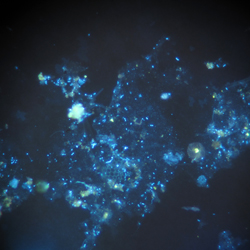
ALOHA is located in the North Pacific subtropical gyre. One of five major circulating ocean currents, this gyre swirls counterclockwise through the North Pacific. Near Hawaii, the waters are fairly warm and nutrient-poor, so the ecosystem is dominated by picophytoplankton. These are tiny cells (0.2-2 microns – about one hundredth the width of a human hair) that convert sunlight and inorganic nutrients into useful biological matter through photosynthesis. Since there are not many nutrients available in the water, the plankton has to get them from other sources. Other organisms that cannot photosynthesize depend on the nutrients that they get from eating phytoplankton. This includes bacteria; since there are few other nutrients around, hungry bacteria colonize particles that are agglomerations of dead phytoplankton and the waste produced by organisms that eat the phytoplankton. On this cruise, we will study these particles to better understand the bacterial interactions on them.

